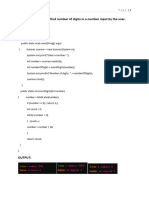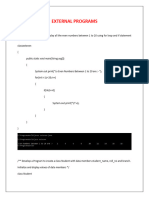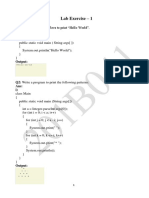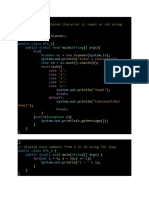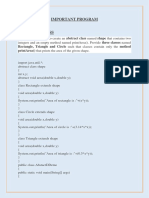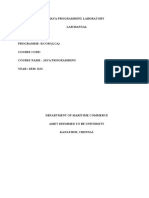17CS2014 - Java Programming Lab URK17CS045: Ex. No. 6 Abstract Classes and Objects
Uploaded by
Eco Buy17CS2014 - Java Programming Lab URK17CS045: Ex. No. 6 Abstract Classes and Objects
Uploaded by
Eco Buy17CS2014
–Java Programming Lab URK17CS045
Ex. No. 6 Abstract Classes and Objects
Date of Exercise 14 – 2 - 2019 Mark (5)
Question-1 (Hackerrank)
Aim
To create a class called MyBook that inherits from an abstract class Book.
Algorithm
Step 1: Start the program.
Step 2: Create an abstract class called Book.
Step 3: Create a class called MyBook that extends Book, in the class MyBook create a function
setTitle() that sets the value passed in the argument to the member value for the class.
Step 4: In the main class, create objects for MyBook.
Step 5: Input the string.
Step 6: Call the setTitle() function from class setTitle() by passing a String value.
Step 7: Stop the program.
Program
import java.util.*;
abstract class Book{
String title;
abstract void setTitle(String s);
String getTitle(){
return title;
}
}
class MyBook extends Book {
@Override
public void setTitle(String title) {
this.title = title;
}
@Override
public String getTitle() {
return title;
}
}
Ex No. 6 | Abstract Classes and Objects 1
17CS2014 –Java Programming Lab URK17CS045
public class Main{
public static void main(String []args){
//Book new_novel=new Book(); This line prHMain.java:25: error: Book is abstract; cannot be instantiated
Scanner sc=new Scanner(System.in);
String title=sc.nextLine();
MyBook new_novel=new MyBook();
new_novel.setTitle(title);
System.out.println("The title is: "+new_novel.getTitle());
sc.close();
}
}
Output
The title is: A tale of two cities
Ex No. 6 | Abstract Classes and Objects 2
17CS2014 –Java Programming Lab URK17CS045
Question-2 (Hackerrank)
Aim
To create a class called MyCalculator that implements AdvancedArithmetic.
Algorithm
Step 1: Start the program.
Step 2: Create a class called MyCalculator that implements AdvancedArithmetic interface.
Step 3: In the class create a function that returns the sum of divisors of a number by using a loop
that runs from 2 to the number itself.
Step 4: Call the function from main function.
Step 5: Do the calculation and return the result.
Step 6: Print the required output.
Step 7: Stop the program.
Program
import java.util.*;
interface AdvancedArithmetic{
int divisor_sum(int n);
}
class MyCalculator implements AdvancedArithmetic {
public int divisor_sum(int n) {
int z, sum=0;
for(int i=2; i<=n; i++) {
if(n%i==0) {
sum+=i;
}
}
return sum+1;
}
}
class Solution{
public static void main(String []args){
MyCalculator my_calculator = new MyCalculator();
System.out.print("I implemented: ");
ImplementedInterfaceNames(my_calculator);
Scanner sc = new Scanner(System.in);
int n = sc.nextInt();
System.out.print(my_calculator.divisor_sum(n) + "\n");
Ex No. 6 | Abstract Classes and Objects 3
17CS2014 –Java Programming Lab URK17CS045
sc.close();
}
/*
* ImplementedInterfaceNames method takes an object and prints the name of the interfaces it implemented
*/
static void ImplementedInterfaceNames(Object o){
Class[] theInterfaces = o.getClass().getInterfaces();
for (int i = 0; i < theInterfaces.length; i++){
String interfaceName = theInterfaces[i].getName();
System.out.println(interfaceName);
}
}
}
Output
I implemented: AdvancedArithmetic
12
Ex No. 6 | Abstract Classes and Objects 4
17CS2014 –Java Programming Lab URK17CS045
Question-3
Aim
To create a class that implements the predefined java CharSequence interface found in the
java.lang.package.
Algorithm
Step 1: Start the program.
Step 2: Create a class called Test that implements CharSequence.
Step 3: In the class Test override all the functions that belong to the interface CharSequence. The
functions include charAt where the element at positon arg0 is returned and length that returns the
length of the char array.
Step 4: In the constructor of the class, convert the String value passed into an charArray using
the toCharArray function. Now create a loop that reverses a char array into another array with
one loop variable runs from array size-1 (last element) to the start. Swap the two elements hence
giving the reverse of the String passed.
Step 5: Have a method that returns the reversed String.
Step 6: In the main function create an object for the class Test and pass a String value
Step 7: Call the getReverse() function and print the result.
Step 8: According to each of the functions of CharSequence do the required, and return the
result.
Step 9: Stop the program.
Program
package ex6;
import java.lang.CharSequence;
public class Test implements CharSequence{
private String inputString;
private char[] reverseString;
//private String resultReverse;
private char[] cloneString;
Ex No. 6 | Abstract Classes and Objects 5
17CS2014 –Java Programming Lab URK17CS045
Test(String inputString) {
reverseString = inputString.toCharArray();
cloneString = reverseString.clone();
int j = reverseString.length-1;
for(int i=0; i<reverseString.length; i++) {
cloneString[j] = reverseString[i];
j--;
for(int i=0; i<reverseString.length; i++) {
System.out.print(cloneString[i]);
@Override
public char charAt(int arg0) {
// TODO Auto-generated method stub
return cloneString[arg0];
@Override
public int length() {
// TODO Auto-generated method stub
Ex No. 6 | Abstract Classes and Objects 6
17CS2014 –Java Programming Lab URK17CS045
return cloneString.length;
@Override
public CharSequence subSequence(int arg0, int arg1) {
// TODO Auto-generated method stub
return cloneString.toString().subSequence(arg0,arg1);
package ex6;
import java.util.Scanner;
public class MainFn {
public static void main(String[] args) {
Scanner scan = new Scanner(System.in);
String s=null;
System.out.println("Enter the string: ");
s=scan.next();
Test t = new Test(s);
System.out.println("\n"+t.length());
System.out.println(t.charAt(0));
Ex No. 6 | Abstract Classes and Objects 7
17CS2014 –Java Programming Lab URK17CS045
Output
Result
The programs have been verified and executed successfully.
Video Link
https://youtu.be/OfphZxyehHM
Ex No. 6 | Abstract Classes and Objects 8
You might also like
- CS508 Midterm Solved Current Subjective Papers Withrefernces50% (4)CS508 Midterm Solved Current Subjective Papers Withrefernces14 pages
- Java Lab 2025_B.tech-4th Semester_Upto ArrayNo ratings yetJava Lab 2025_B.tech-4th Semester_Upto Array5 pages
- String String System: Out Println CharatNo ratings yetString String System: Out Println Charat19 pages
- 018 Assignment Solutions - Problems On Loops - 2No ratings yet018 Assignment Solutions - Problems On Loops - 217 pages
- Durga Oops Through Java Lab Manual Programs (Cse)No ratings yetDurga Oops Through Java Lab Manual Programs (Cse)52 pages
- Kuvempu University: Laboratory Assignments Subject: JAVA Programming Subject Code: BSIT - 42No ratings yetKuvempu University: Laboratory Assignments Subject: JAVA Programming Subject Code: BSIT - 429 pages
- Java Practical Programs and Answers By MCA Scholar's GroupNo ratings yetJava Practical Programs and Answers By MCA Scholar's Group21 pages
- Tutorial - Week: 3: IT0206 - Programming in Java LABNo ratings yetTutorial - Week: 3: IT0206 - Programming in Java LAB19 pages
- Getting Started With Java IDL: Writing The Interface DefinitionNo ratings yetGetting Started With Java IDL: Writing The Interface Definition5 pages
- SYSC2006_L01_Imperative_programming_intro_CNo ratings yetSYSC2006_L01_Imperative_programming_intro_C33 pages
- Using Using Using Namespace Class Int Public Void: C# Example Class & ObjectNo ratings yetUsing Using Using Namespace Class Int Public Void: C# Example Class & Object44 pages
- Inheritance Abstraction Polimorphism Conclusion Reference: Erika Ehrli Cabral March 2005No ratings yetInheritance Abstraction Polimorphism Conclusion Reference: Erika Ehrli Cabral March 20057 pages
- This Tutorial Letter Contains Important Information About Your Assignment 2No ratings yetThis Tutorial Letter Contains Important Information About Your Assignment 226 pages
- Sample of Project Report For Class 11 Students75% (8)Sample of Project Report For Class 11 Students10 pages
- Formal Languages and Automata Theory Department of Computer ScienceNo ratings yetFormal Languages and Automata Theory Department of Computer Science5 pages
- Object Oriented Software Engineering Mod PDFNo ratings yetObject Oriented Software Engineering Mod PDF4 pages
- Object Oriented Programming Lab 02 Classes and Objects: Class DeclarationNo ratings yetObject Oriented Programming Lab 02 Classes and Objects: Class Declaration4 pages
- What Is Visibility in Java?: Java Programming Edit Categories ImproveNo ratings yetWhat Is Visibility in Java?: Java Programming Edit Categories Improve6 pages
- Slides Lambda Expressions Functional Interfaces and Method References Java's Functional Interfaces Consumer & PredicateNo ratings yetSlides Lambda Expressions Functional Interfaces and Method References Java's Functional Interfaces Consumer & Predicate6 pages
- CS508 Midterm Solved Current Subjective Papers WithreferncesCS508 Midterm Solved Current Subjective Papers Withrefernces
- Kuvempu University: Laboratory Assignments Subject: JAVA Programming Subject Code: BSIT - 42Kuvempu University: Laboratory Assignments Subject: JAVA Programming Subject Code: BSIT - 42
- Java Practical Programs and Answers By MCA Scholar's GroupJava Practical Programs and Answers By MCA Scholar's Group
- Tutorial - Week: 3: IT0206 - Programming in Java LABTutorial - Week: 3: IT0206 - Programming in Java LAB
- Getting Started With Java IDL: Writing The Interface DefinitionGetting Started With Java IDL: Writing The Interface Definition
- Using Using Using Namespace Class Int Public Void: C# Example Class & ObjectUsing Using Using Namespace Class Int Public Void: C# Example Class & Object
- Inheritance Abstraction Polimorphism Conclusion Reference: Erika Ehrli Cabral March 2005Inheritance Abstraction Polimorphism Conclusion Reference: Erika Ehrli Cabral March 2005
- This Tutorial Letter Contains Important Information About Your Assignment 2This Tutorial Letter Contains Important Information About Your Assignment 2
- Formal Languages and Automata Theory Department of Computer ScienceFormal Languages and Automata Theory Department of Computer Science
- Object Oriented Programming Lab 02 Classes and Objects: Class DeclarationObject Oriented Programming Lab 02 Classes and Objects: Class Declaration
- What Is Visibility in Java?: Java Programming Edit Categories ImproveWhat Is Visibility in Java?: Java Programming Edit Categories Improve
- Slides Lambda Expressions Functional Interfaces and Method References Java's Functional Interfaces Consumer & PredicateSlides Lambda Expressions Functional Interfaces and Method References Java's Functional Interfaces Consumer & Predicate








